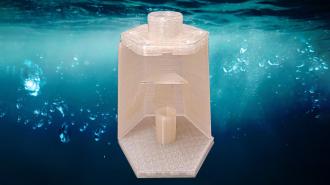Maryland high school students have developed an ultra low-cost device to filter out lead in water. Aside from being cheaper than conventional systems, the filter also has a built-in warning system that lets users know when it needs to be replaced.
Why it matters: The EPA estimates that 6 to 10 million homes still get their water from lead pipes. If the chemistry of the water in those pipes changes, the pipes can corrode and leak lead into drinking water.
Lead is toxic, and consuming it can cause heart, kidney, and reproductive problems in adults. Children, meanwhile, can suffer lower IQs, behavioral problems, slowed growth, and more if even low levels of lead make it into their bloodstreams.
The challenge: While the U.S. has made enormous progress in reducing lead exposure in the last few decades, and steps are being taken to replace the remaining lead pipes, the transition won’t happen overnight. Finding pipes contaminated with lead and replacing them is a costly and often slow process.
In the meantime, people can use filtration systems to remove lead in water, but those filters can be bulky and expensive, and it can be hard to tell if they’re actually working or in need of replacement.
Children who consume lead can suffer lower IQs, behavioral problems, slowed growth, and other health problems.
“A few years ago, I saw a video of a woman in Michigan turn on her tap water, and it came out brown,” said Rebecca Bushway, the Maryland students’ teacher at Barrie Middle and Upper School and the project’s principal investigator.
“That made me think — because there’s really no safe level of lead in drinking water, wouldn’t it be nice to have a water filter that could tell you that your water is contaminated, well before it turns brown because of lead?” she continued.
The idea: In 2020, Bushway discussed the problem of lead in water with her chemistry students, who were learning from home at the time due to COVID-19, and they quickly started brainstorming ideas for a low-cost water filter.
The water leaving the filter takes on a yellow hue when the device can no longer remove lead.
When they returned to the classroom in 2021, they used biodegradable plastic to 3D print a prototype device that would attach directly to a home faucet. They then added calcium phosphate and potassium iodide powder to the interior of the device.
“Calcium phosphate first binds with dissolved lead in water to form lead phosphate and free calcium,” said Bushway. “The calcium, which is harmless, ends up in the water, and the lead phosphate stays in the filter.”
When the calcium phosphate can no longer remove lead from the water, the potassium iodide powder at the very bottom of the device reacts to the lead. This causes the water leaving the filter to take on a yellow hue — this is the sign to users that it’s time to replace the device.
Fixed with science: It took more than a dozen failed prototypes to get everything just right, but the students now have a working water filter that Bushway presented at the spring meeting of the American Chemical Society.
During the presentation, she noted that the team is hoping to find partners to help it make and distribute the device, which she expects could be sold for as little as $1.
“Ultimately, this experience has shown students that they can make a difference to somebody, and there are problems that they can fix with science,” Bushway said.
We’d love to hear from you! If you have a comment about this article or if you have a tip for a future Freethink story, please email us at [email protected].






